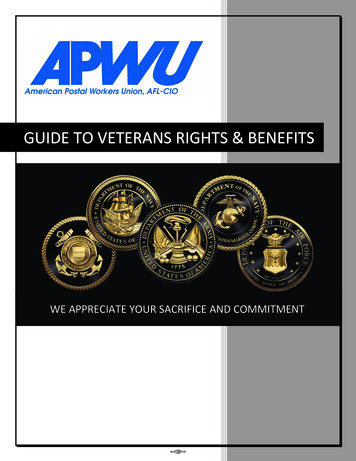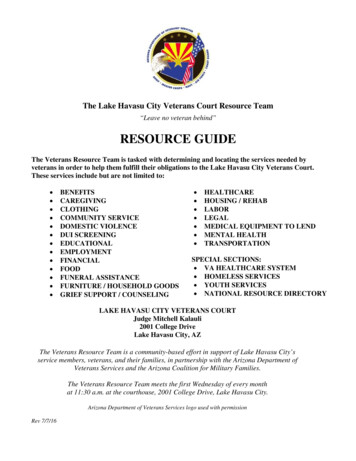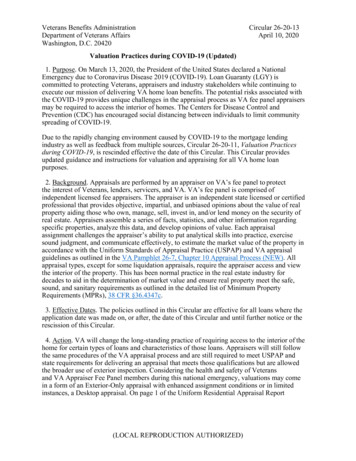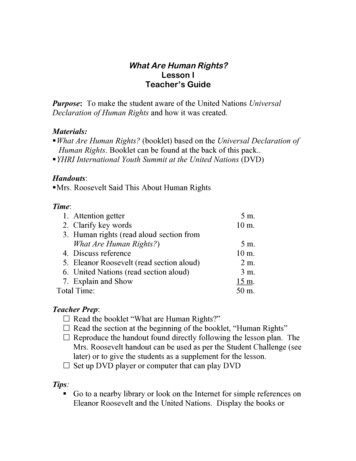
Transcription
GUIDE TO VETERANS RIGHTS & BENEFITSWE APPRECIATE YOUR SACRIFICE AND COMMITMENT
Dear Military Veteran and APWU Member,The APWU membership includes tens of thousands of proud military veterans, many withservice- connected disabilities, who are now proud and dedicated postal workers and membersof our union. Many APWU retirees are also veterans.The APWU is pleased to share this booklet with you, designed as a quick reference guide onimportant rights and benefits of veterans employed by the United States Postal Service.While this guide cannot address every issue, it includes topics of interest to veterans, includingLeave Accrual, Wounded Warriors Leave, Employment and Reemployment Rights, MeritSystems Protection Board (MSPB) rights and Retirement Credit for Military Service. Weencourage you to explore the “Veterans Issues” section of the APWU website athttps://apwu.org/veterans-issues for further information on veteran-related issues and manyother subjects important to postal workers.In addition, a new “APWU Veterans Network” was launched in 2021 to provide opportunities toconnect with other APWU veterans and stay informed on important issues.We encourage you to avail yourself of your veteran-earned rights as well as to be fully involvedin the union and the continuing struggle to improve the rights and well-being of postal workersand defend and expand the public Postal Service.The APWU national leadership appreciates your sacrifice and commitment and we hope thisguide proves to be a valuable resource to you.Sincerely and in Union Solidarity,Mark DimondsteinAPWU President2
Table of ContentsAPWU Veterans Network . 4Legislative Agenda . 5Veterans’ Preference Act of 1944 . . 6Annual Leave AccrualRetirement Credit for Military Service – “Military Buy-Back” . . 8Annual Leave Accrual . . 9Military Leave . 13Wounded Warriors Leave . . 17Medical Appointments for Veterans with Disabilities . . . 22On-the-Job Injuries – OWCP/VA Dual Coverage . 24Veterans and Mental Health . 26Layoffs and Reduction in Force . . . 29Merit Systems Protection Board (MSPB) . 32Reinstatement and Reemployment . 36Uniformed Services Employment and Reemployment Act of 1994 (USERRA). 37Resources . 39The following sections pertain to Postal Support Employees: APWU Veterans Network;Legislative Agenda; Medical Appointments for Veterans with Disabilities; OWCP/VA DualCoverage; Uniformed Services Employment and Reemployment Act of 1994 (USERRA);Veterans’ Preference Act of 1944; Wounded Warriors Leave and Resources.3
APWU Veterans NetworkThe American Postal Workers Union, AFL-CIO remains dedicated to keeping veterans, guardreservists, family members and union representatives informed about protections, rights,benefits, program services and changes that may affect them.The APWU Veterans Network was launched in 2021 with a twofold purpose:Annual Leave AccrualFirst, to provide opportunities to connect with other APWU veterans, provide supportfor each other and stay informed on important issues, andSecond, to help advance the general goals of the APWU and the labor movement.APWU veterans share valuable experiences and are embedded in their local communities, inboth veteran and non-veteran related causes and events. Their continued service fosters agenuine pride and with a focus on teamwork and purpose, the APWU Veterans Networkembraces the shared values of our veteran members and the American Postal Workers Union.4
Legislative AgendaOn Capitol Hill, lawmakers are constantly debating issues and considering proposals that affectveterans and members of the American Postal Workers Union. The APWU LegislativeDepartment monitors legislative activity to anticipate potential effects on members and ourfamilies. In addition, the APWU promotes and mobilizes for pro-postal, pro-worker, pro-unionlegislation.Even prior to the start of the 117th Congress, your legislative department was already meetingwith incoming representatives to explain the importance of protecting veterans’ preference andveterans’ critical contributions to the Postal Service. Often, groups that are opposed to ourmembers’ best interests propose legislation designed to undermine decades of progress thelabor movement and the APWU have achieved.Annual Leave AccrualThe APWU has been successful in defending against attacks in Congress that threaten ourmembers’ collective-bargaining rights, retirement benefits, and livelihood. We want to continuehelping to elect House and Senate candidates who will protect our rights and benefits, promoteour issues, and deliver our message to Washington.Veterans have significant influence in Washington on issues such as retirement, social securityand health care benefits, hiring preference, legislation that supports the public Postal Serviceand postal/veteran jobs, veterans’ programs, or proposals that affect the Department of VeteransAffairs. This gives veterans a strong voice when they contact their senators and congressionalrepresentatives to encourage them to act on proposed legislation.The APWU Legislative Department is proactive in both monitoring and promoting legislation thataffects our members and our veterans. Please visit the APWU Legislative and PoliticalDepartment webpage for legislative resources. https://apwu.org/legislative-and-political.5
Veterans’ Preference ActCongress passed the Veterans’ Preference Act of 1944 to ensure veterans military service wouldnot hinder their employment opportunities upon their return to civilian life. The Act originallyrequired the federal government to promote returning war veterans when hiring new employees.Over the years, its protections have expanded to include other veterans meeting eligibilityrequirements, irrespective of whether they served during a war.Annual Leave AccrualTo qualify for preference in hiring and for up to extra ten points on a passing score of the entranceexaminations, veterans must be discharged under honorable conditions and meet the criteria forone of the preference categories. Veterans must have either sustained a service-connecteddisability, served during the specific periods listed in Handbook EL-312, Employment andPlacement, or qualified under the “sole survivor discharge criteria in Section 483 of HandbookEL-312.Employees with questions regarding veterans’ preference, relative standing and seniority areencouraged to review Handbook EL-312 and the Collective Bargaining Agreement, both of whichare available on the APWU website at https://apwu.org/. Veterans should contact USPS HumanResources Shared Services Center (HRSSC) at 877-477-3273 and select option 5 if they believetheir veterans’ preference eligibility category is incorrect or changes during their employment.The Veterans’ Preference Act of 1944 not only benefits veterans during the hiring process; italso guarantees additional rights to employed veterans regarding job security. These rights,which originally applied only to war veterans, provided specific notice and appeal rights inmatters of employee discipline. These rights have been subsequently expanded to protect otheremployees with veterans’ preference, provided they have served one year of current, continuousservice. A break in service of one workday during the year disqualifies an employee from theserights. This means that Postal Support Employees would not be protected unless they workedat least 365 days without a break in service.According to the Act, a federal employer could not initiate an adverse action against a warveteran without good cause and without first providing 30 days’ written notice of the allegationsand an opportunity to respond. The veteran then could appeal the adverse action to the CivilService Commission, which was the predecessor to the present-day Merit Systems ProtectionBoard (MSPB). Adverse actions are defined in Section 1201.3 of Title 5 of the Code of FederalRegulations (CFR):1201.3 Appellate jurisdiction.Adverse Actions. Removals (terminations of employment after completion of probationary orother initial service period), reductions in grade or pay, suspension for more than 14 days, orfurloughs for 30 days or less for cause that will promote the efficiency of the service; aninvoluntary resignation or retirement is considered to be a removal.6
Article 16, Section 9 of our Collective Bargaining Agreement outlines preference eligibleveterans’ rights with respect to the Act and states in relevant part:Article 16, Section 9. Veterans’ PreferenceA. A preference eligible is not hereunder deprived of whatever rights of appeal such employeemay have under the Veterans’ Preference Act; however, if the employee appeals under theVeterans’ Preference Act, the employee will be deemed to have waived further access to thegrievance-arbitration procedure beyond Step 3 under any of the following circumstances:1.if an MSPB settlement agreement is reached;2.if the MSPB has not yet issued a decision on the merits, but a hearing on themerits before the MSPB has begun;3.if the MSPB issues a decision on the merits of the appeal.B. In the event the grievance of a preference eligible is due to be scheduled in accordance withArticle 15, Section 5, and the preference eligible has a live MSPB appeal on the same action theparties will not schedule the grievance for arbitration until a final determination is reached in theMSPB procedure. If the grievance is not waived under Section 9.A.1, 2, or 3 above, the case willbe scheduled promptly for arbitration. Should the grievance ultimately be sustained or modifiedin arbitration, the preference eligible employee will have no entitlement to back pay under theNational Agreement for the period from the date the case would have been scheduled forarbitration and the date it is actually scheduled for arbitration.7
Retirement Credit for Military Service – “Military Buy-Back”As a general rule, military service in the Armed Forces of the United States is creditable forretirement purposes if it was active service terminated under honorable conditions, and if it wasperformed prior to your separation from civilian service for retirement.Far too many of our veterans who have served in the military wait until immediately beforeretirement to buy back their service time, without realizing how long the process can take.Obtaining all the necessary paperwork to buy back time may take several weeks; therefore, werecommend that you begin the process as soon as possible.Why should you consider buying back your military time? Making military service payments couldincrease the amount of your annuity and could add credit to your eligibility for retirement. Makingthese payments helps ensure that you will not suffer a future reduction of your OPM annuity ifyou qualified for Social Security benefits. If your active military duty ended prior to Dec. 31, 1956,and you are in the Civil Service Retirement System (CSRS) program, you will receive full creditwithout needing to make a deposit for either your retirement eligibility or annuity calculations.These rules change, however, for CSRS and FERS employees who served in the military afterJan. 1, 1957. Information for these employees can be found in Chapters 21, 22, and 23 of theCSRS and FERS Handbook for Personnel and Payroll Offices, which can be found online atwww.opm.gov/retire/pubs/handbook/hod.htm.You can begin calculating what effect buying back your military time will have on your retirementeligibility by verifying the date your military service ended. To do so, you must obtain a copy ofyour discharge papers (Form DD 214) by submitting a written request to:National Personnel Records CenterMilitary Personnel Records1 Archives DriveSt. Louis, MO 63138The NPRC may also be reached at:Telephone: 314-801-0800Fax: 314-801-9195Upon your submission of Form DD 214, the finance center for your particular service branch willsend you your estimated military earnings computation. The USPS Human Resources SharedServices Center can then use this information to determine the amount of your deposit, ifapplicable. If you choose to buy back your military time, the deposit must be paid prior to thedate you retire from the USPS. Don’t forget to retain your proof of payment.8
Annual Leave AccrualCareer employees earn annual leave based on their years of creditable service. Creditableservice is determined by adding time spent as a career Postal Employee and qualifying priormilitary service. Career employment in other federal agencies may also be added depending onthe nature of the service.Full-time employees are credited with annual leave as set forth in Section 512 of the Employeeand Labor Relations Manual (ELM) based on their leave category. The following chart showshow the amount of leave earned is determined:Annual Leave Accruala. Accrual Chart. Table 1:b. Credit at Beginning of Leave Year. Full-time career employees are credited at the beginningof the leave year with the total number of annual leave hours that they will earn for that leaveyear.c. Changes in Employee’s Accrual Rate. Leave credit at the beginning of the leave year reflectsany change in an employee’s accrual rate for that year.d. Change From Part-time to Full-time. An employee who changes from a part-time to a fulltime employee after the start of a leave year is credited with the annual leave to be earnedfor the remainder of the leave year.e. Nonpay Status. Leave credit for periods in which an employee is in a nonpay status is reducedduring the leave year as follows:(1)When an employee’s absence in a nonpay status totals the equivalent of 1 payperiod of regular service during the leave year (10 days or 80 hours), credit forleave is reduced by the amount of leave earned by the employee in a pay period.9
(2)When an employee has one or more periods of LWOP during the leave year, allhours in a nonpay status (during periods in which the employee earned annualleave) are totaled to reduce leave credits.Part-time employees accrue annual leave according to their years of creditable service and thenumber of hours worked in a pay period, according to the following chart from Section 512 ofthe ELM: Exhibit 512.312.Military veterans may receive additional years of creditable service toward annual leave accrual.Section 512.23 of the ELM defines the military service that qualifies:512.23 Military Service Counted512.231 Service of an Employee Not Eligible for Military Retirement AnnuityThe following military service is used in computing the years of service that determine the annualleave category:a.Periods of active service terminated by honorable discharge or transfer to inactivereserves under honorable conditions. Active service may be in the Army, Air Force,Navy, Marine Corps, and/or Coast Guard and their respective academies.b.Service performed by employees who are members of the National Guard Service orAir National Guard Service only during periods of active duty with the U.S. Army or U.S.Air Force.10
c.Service performed by Naval Reserve Officers Training Corps students during periodsof active duty or training duty as members of the Naval or Marine Corps Reserve.Note:Veterans Affairs (VA) disability payments for service-connected injuries or illnesses arenot retirement annuities. If a VA disability payment is received and the employee is noteligible for a military retirement annuity, 512.231 applies. If the employee is eligible fora military retirement annuity, 512.232 applies.For example, an employee with two (2) years of career service would normally be in LeaveCategory 4. However, an employee with two (2) years of career service who had been honorablydischarged after previously serving six (6) years of active military duty accrues annual leaveunder Leave Category 6. The years of active military service also count towards reaching thenext leave earning category, so this same employee would reach Leave Category 8 after onlynine (9) years in the Postal Service, rather than the 15 years it would take without the six (6)years of active duty military service.Unlike obtaining retirement credit, there is no requirement for a veteran to “buy back” militaryservice in order for it to increase the annual leave accrual rate. Additionally, military retirees maybe eligible to have their service credited for annual leave accrual, in specific circumstances:512.232 Service of an Employee Eligible for Military Retirement AnnuityThe following military service is used in computing the years of service that determine the annualleave category:a. Full Credit. Full leave accrual credit for all of active military service is granted if a militaryretiree meets one of the following four conditions:(1)Retirement was based on disability resulting from injury or disease received in the lineof duty as a direct result of armed conflict.(2)Retirement was based on disability caused by an instrumentality of war and incurred inthe line of duty during a period of war defined in 38 United States Code (U.S.C.) 101and 301.(3)On November 30, 1964, the employee was employed in a civilian office to which theAnnual and Sick Leave Act of 1951 applied and continues to be employed in a civiliancapacity without a break in civilian service of more than 30 days.(4)The individual first becomes eligible for a uniformed services annuity while serving as acareer employee. This provision applies to members of the Reserve Component of theArmed Forces (Reserves and National Guard) who (a) qualify for an annuity becauseof reserve service or (b) are involuntarily recalled to active duty under Title 10, qualifyfor uniformed services retirement during that period of active duty, and then are restoredto federal civilian employment on completion of that period of involuntary military service.11
This provision applies only to the employee’s current period of civilian employment; ifthe employee separates and is reemployed later, the provision is no longer applicable.b. Partial Credit. Military retirees who do not qualify for full leave accrual credit can qualify forpartial credit based on the following:(1)Service for determining an employee’s leave category is restricted to the actual lengthof time in active service in the armed forces during any war or in any nonwartimecampaign or expedition for which a campaign badge was authorized.(2)Service in a nonwartime campaign or expedition does not entitle the military retiree tocredit for the duration of the campaign or expedition but only for the period of service inthe campaign or expedition.Military veterans should review their PS Form 50 to ensure they have been given appropriateleave accrual credit for their military service.12
Military LeaveThe following rules and regulations pertaining to the crediting and usage of paid military leaveare found in Section 517 of the Employee and Labor Relations Manual (ELM):517 Paid Military Leave517.1 General517.11 Postal Service SupportAnnual Leave AccrualThe Postal Service supports employee service in the Reserve or National Guard, and no actionis permitted to discourage either voluntary or involuntary participation. The Postal Service allowsemployees to be absent:a.To participate in drills or meetings scheduled by the National Guard or Reserve Units ofthe armed forces.b.To attend usual summer training periods.c.To perform any other active duty ordered by the National Guard and Reserve Units of thearmed forces.However,
preference eligible employee may file both a grievance and an MSPB appeal protesting an adverse action, he or shemust choose which appeal to pursue by the date the grievance is scheduled for arbitration. Information on appeal rights and time limits for filing an MSPB appeal are fou











